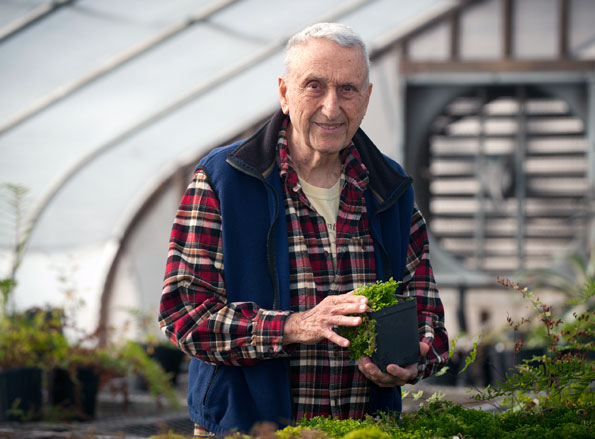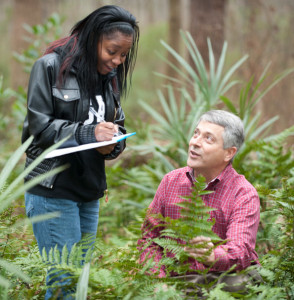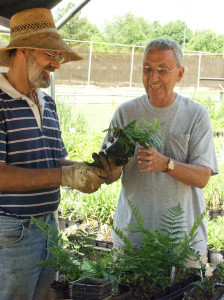
George Sanko has spent more than 23 years building the gardens on GPC’s Decatur Campus. (Photo by Bill Roa)
Retired Professor Transforms Wasteland into Botanical Treasure
By Rebecca Rakoczy
Don’t call George Sanko a gardener.
Yes, he is the man who almost singlehandedly transformed a briar-infested, 4-acre plot on Georgia Perimeter College’s Decatur Campus into a native plant and fern garden whose scope and variety have drawn international attention.
Yes, he has been recognized by national gardening clubs and international fern societies for his work, and syndicated gardening experts remark on his plant expertise.
But Sanko doesn’t see himself as a gardener.
“My background is botany, and I love collecting and identifying plants,” says the 81-year-old Sanko. “I want to learn about them and know everything there is about them, but not necessarily garden with them. I’m not a gardener. That’s just not me.”
So, how does Sanko see himself? “CEO of the GPC Botanical Garden, teacher and plant educator and chief fundraiser,” he says.
Sanko has been associated with Georgia Perimeter College for almost half a century. He served as a botany professor for 25 years, retired from full-time work in 1989, then turned part-time. When he left the classroom, he began volunteering—applying his hours and energy toward clearing what is now the garden land.

GPC biology instructor Rick Barnes, here with student Ashley Burton, uses the garden to demonstrate and reinforce biological concepts he teaches in class. (Photo by Bill Roa)
A longterm project
The property—two thirds of which is in a flood plain—was a wasteland of overgrowth and trash. Sanko, aided by students and other volunteers, spent the past 23 years shaping that property into the GPC’s Native Plant Botanical Garden.
Along his way, from classroom to garden, Sanko has left a trail of inspiration.
Rick Barnes, a volunteer at the gardens, says Sanko impacted his life in more ways than one.
“I really had no idea what I wanted to do, and I was right out of high school,” Barnes says. “A friend of mine heard about this crazy botany professor at DeKalb College (the forerunner of GPC) who took his classes on backpacking trips. I thought, ‘that’s what I’d like to do.’ That was 1974.”
The “crazy botany professor” was Sanko, and from him Barnes quickly acquired a deep knowledge of native plants. Sanko was his mentor, guiding him toward a degree in horticulture at the University of Georgia after he received his associate degree at DeKalb College.
“I became re-acquainted with George about 1998,” Barnes says. “At the time, I was chairman of the Georgia Green Industry Association, and he was selected by the board as GGIA Educator of the Year in 1998. It was a great honor for me to present that to him, and we have been a lot closer ever since.”
Today, in addition to teaching biology lab classes at Georgia Perimeter’s Decatur Campus, Barnes works with one of Atlanta’s leading commercial landscaping companies and still finds time to volunteer with the college garden, which he uses as an outdoor laboratory for his GPC students, offering real life examples of the earth’s biomes and ecosystems.

George Sanko’s displays his legendary and infectious enthusiasm during a plant discussion with Bill Troschak. (Photo by Bill Roa)
Spreading the word
In the early days of the botanical garden, Sanko visited garden clubs to get the word out about the hidden gem on the Decatur Campus. “I talked to at least 30 garden clubs in metro Atlanta, Tallahassee and in Dallas,” Sanko says. He also spoke to environmental groups and landscaping associations. Those public relations forays in the 1990s garnered intense respect for Sanko, who became known for imbuing his talks about native plants with a passion akin to a preacher at a tent meeting.
“George is so enthusiastic, it really sets him apart from a lot of gardening educators—only a few fit that mold,” notes syndicated gardening columnist and radio show host Walter Reeves. “When George gets on the stage, he’s proselytizing. He’s going to convert you on his ideas of how plants should be treated—he is going to make you a believer or die trying.”
Sanko already was delving into understanding native plants before such gardening became the national rage. Over the years, he has taken gardening aficionados on trips across the country, sourcing plants native to the continental United States, from the mountains of Tennessee to the deserts of Arizona.
“I wanted to know everything about them,” he says. Trillium and native azaleas soon became the backbone of an extensive shade garden he calls his “spring ephemerals.”
“George has an incredible knowledge. He’s an amazing resource,” says Tucker resident Jon McKenna, who has been coming to the botanical garden’s seasonal sales for at least five years and estimates he has purchased a “couple hundred” plants during that time.
“I first learned about the garden in a Walter Reeves book on native plants,” McKenna says. “Going to this place is so refreshing, because you can find things with history and variation, and the people there are so knowledgeable.”
The seasonal sales that McKenna and other garden lovers patronize are helpful because they produce revenues the garden uses to add new plants. Aside from those funds, the garden operation runs on volunteers and donations.
George’s ‘wheelhouse’
Sanko began collecting ferns in the early 2000s, part of his dream to create a garden that is large, diverse and—most importantly—different from other gardens. He wanted the garden to be a teaching garden for students and the community.
“Anything he can do to make it different—xeric beds composed of sand or Perma-till to support drought-tolerant western plants, scree (loose rock) beds in the shade—these are things that few gardens try,” Barnes says. “This is George’s wheelhouse.”
It didn’t take long for Sanko to amass the largest and most diverse fern collection in the country. In 2011, GPC’s “Ferns of the World” garden was barely eight years old when it was visited by a group from the British Pteridological Society and its American counterpart, the Hardy Fern Foundation. The garden was recognized that year by the foundation as the best in the United States, and Sanko was recognized personally in 2011 with an “Award of Excellence” from the National Garden Clubs in Washington, D.C.
Mission: education
Sanko is keen on keeping the garden true to its mission of educating those who visit. During the fall and spring, guest speakers (including Sanko) give tours of the garden and provide lectures on various plants and their care. In the past year, Sanko and his volunteers changed the format of the sun gardens, installing winding paths and removing the square bed format that characterized the garden for more than a decade. While the original square beds held visual appeal, Sanko had eyed the visitors’ experience in the garden as a teacher.
![society-visit_0000051[1] society-visit_0000051[1]](/gpcthechroniclearchive/wp-content/uploads/2013/03/society-visit_00000511-300x208.jpg)
George Sanko conducts a garden tour for U.S. and British fern experts visiting in 2011. (Photo by Rod Reilly)
“I would watch people come in to the garden for quite a few years with the square beds,” Sanko says. “ … You couldn’t see everything, you couldn’t see the labels. That was wasted from an educational standpoint. We rearranged it so people could teach more about the collection; so visitors could also feel and see the botanical name and a person could break off a flower if they wanted to. You need to get near something in order to learn about it.”
Passing the baton
Now, after decades of volunteer service, health issues have forced Sanko to cut back his visits to the garden. He wonders about its future when he can no longer come and direct its care.
Devoted community groups and volunteers have worked the garden, but there is no single steady hand—or source of financial support—to lead the garden to its next phase, he says.
“Right now, all we can do is maintain the garden,” Sanko says. “There is tremendous room for improvement. I need someone who can lead and knows how to dig in the garden and knows native plants.”
That is not all.
“We need someone to steer the ship,” he says.
“It has so much potential,” says Sanko. “We haven’t even touched programming on the weekends because I just can’t do it.”
Sanko is like a proud parent when it comes to the plants—he loves them all. Well, almost all. There are a few that test his patience. One example: the truly native—but oh-so-invasive—mountain mints. “Thugs,” he says, with his trademark humor. “You got to control them, or they’ll take over the garden.”
Other selections, however, receive strong praise.
“There are so many fantastic plants, if I could only choose one, I would just say goodbye—I would have to let them all go. I’d leave them together as a group,” he says.
If, however, he had to save just one segment of the garden,” he says. “I would have to say even though we have the finest fern collection in the country, I still would make the effort to save the shade area, the trilliums and all that. That’s how I got started, and if I had to end it, that’s how I would end it.”
Anyone interested in making a gift to the GPC Botanical Garden can contact the GPC Foundation at 678-891-2550 or mail a donation to the GPC Botanical Garden, Attn.: GPC Foundation, 3251 Panthersville Road, Decatur, GA 30034.
For more information, visit the garden’s website or enjoy a video tour.







On the Cover | GPC The Chronicle on April 12, 2013 at 1:49 pm.
[…] On the southeastern tip of Georgia Perimeter College’s Decatur Campus sits a botanical garden whose ferns and native plants delight visitors from around Atlanta and the world. But that 4-acre plot of land would still be a briar-infested wasteland of overgrowth and trash were it not for the vision and energy of former GPC botany professor Dr. George Sanko. Sanko, shown here in the garden greenhouse, is now 81. He’s devoted 25 years in GPC’s classrooms and, as a retiree and volunteer, given the last 23 years to developing and nurturing the natural showcase. Read more … […]
George’s Garden (Video) | GPC The Chronicle on April 13, 2013 at 11:26 am.
[…] George Sanko is the man who almost singlehandedly transformed a briar-infested, 4-acre plot on Georgia Perimeter College’s Decatur Campus into a native plant and fern garden whose scope and variety have drawn international attention. See article. […]
Alice Murray on April 30, 2013 at 1:27 pm.
Wonderful story! As a former member of the Oakhurst Community Garden (now the Wylde Center) in Decatur, I thought some of the folks there might be interested in working with this garden. Certainly worth checking to see. Such a priceless gem needs to be preserved for the future.